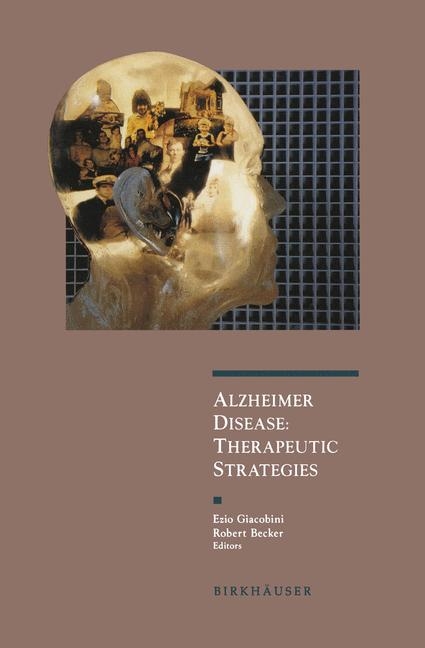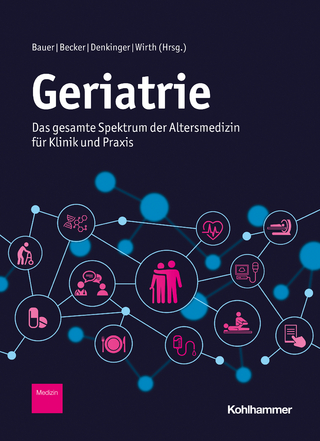
Alzheimer's Disease
Birkhauser Boston Inc (Verlag)
978-0-8176-3757-6 (ISBN)
- Titel ist leider vergriffen;
keine Neuauflage - Artikel merken
Since the apoE4 allele is a risk factor or susceptibility gene in late-onset familial and sporadic AD, the mechanism of disease expression may involve metabolic effects that are isoform specific. Isoform-specific interactions of apoE therefore become critical in the mechanism of AD pathogenesis. Detailed characterization of the binding of the apoE isoforms with proteins and peptides relevant to the pathology of the disease may be critical in understanding disease pathogenesis. These critical isoform-specific interactions of apoE may involve interactions with proteins and pep tides in the defining neuropathologic lesions of the disease, the neurofibrillary tangle and senile plaque. Other possible critical isoform-specific interactions include the mechanism of internalization, intracellular trafficking, and subsequent metabolism. In addition, differential post-translational modifications of apoE isoforms may determine differences in metabolism contributing to the pathogenesis of the disease. Oxidation of apoE may confer several isoform-specific, biochemically distinct properties.
Since {3A peptide binds apoE in the lipoprotein binding domain of the protein and not in the receptor-binding domain, apoE could target bound {3A4 peptide to neurons via the LRP receptor. Internalization of the apoEI {3A peptide complex into the cell, by the same route as the apoE-containing lipoproteins, would result in incorporation into primary lysosomes and pH dependent dissociation. The demonstration of apoE in the cytoplasm of neurons, with isoform-specific interactions of apoE with the microtubule-binding protein tau demonstrated in vitro, suggest additional, testable hypotheses of disease pathogenesis.
Introductions.- Development of Drugs for Alzheimer Therapy: A Decade of Progress.- Epidemiology of AD: Impact on the Treatment.- I. Neuropathologic and Genetic Basis of AD Treatment.- Neuropathological Bases of Alzheimer Disease, Implications for Treatment.- Amyloid Deposition as the Central Event in the Etiology and Pathogenesis of Alzheimer's Disease.- Role of Abnormal Phosphorylation of Tau in Neurofibrillary Degeneration: Implications for Alzheimer Therapy.- Olfactory Bulb Involvement in AD: An Early Change?.- Alzheimer Disease-A Spirochetosis?.- II. Therapeutical Strategies to Arrest Production and Processing of Amyloid.- Beta Amyloid (A?) as a Therapeutic Target in Alzheimer's Disease.- Regulation of APP Processing by First Messengers.- In Vitro Production of Amyloid ?-Protein: A Route to the Mechanism and Treatment of Alzheimer's Disease.- Apolipoprotein E and Alzheimer's Disease: Therapeutic Implications.- Apolipoprotein E4 and Cholinergic Dysfunction in Alzheimer's Disease.- III. The Cholinergic System of Human Brain.- Butyrylcholinesterase in Alzheimer's Disease.- Modulating Cholinergic Neurotransmission Through Transgenic Overexpression of Human Cholinesterases.- Structure-Function Relationships in the Binding of Reversible Inhibitors in the Active-Site Gorge of Acetylcholinesterase.- Cholinergic Changes and Synaptic Alterations in Alzheimer's Disease.- IV. Cholinesterase Inhibitors in AD Treatment.- to Cholinesterase Inhibitors Used in Alzheimer's Disease Therapy.- A Pharmacodynamic Strategy to Optimize the Clinical Response to Eptastigmine (MF-201).- Eptastigmine (MF-201). A Double-Blind, Placebo-Controlled, Clinical Trial in Alzheimer Disease Patients.- Cognition Improvement by Oral Huperzine A: A Novel Acetylcholinesterase Inhibitor.- In Vitro and In Vivo Effects of a Dual Inhibitor of Acetylcholinesterase and Muscarinic Receptors, CI-1002.- Effects of Novel Cholinesterase Inhibitors Based on the Mechanism of Enzyme Inhibition.- Biochemistry, Pharmacokinetics and Pharmacodynamics of MDL 73,745: A Potent and Selective Inhibitor of Acetylcholinesterase.- Clinical Experience with MDL 73,745; Pharmacokinetics, Pharmacodynamics, and Clinical Tolerance in Normal Volunteers.- Galanthamine in Alzheimer's Disease.- Tacrine: An Overview of Efficacy in Two Parallel Group Studies.- Clinical Update of Velnacrine Research.- Second and Third Generation Cholinesterase Inhibitors: From Preclinical Studies to Clinical Efficacy.- Second and Third Generation Cholinesterase Inhibitors: Clinical Aspects.- V. Nicotinic Agonists as Drugs for AD Treatment.- Nicotinic Receptors in Human Brain.- Development of Nicotinic Agonists for the Treatment of Alzheimer's Disease.- The Role of Nicotinic Systems in the Cognitive Disorder of Alzheimer's Disease.- ABT-418: A Novel Cholinergic Channel Activator (ChCA) for the Potential Treatment of Alzheimer's Disease.- Nicotine, Catecholamines and Cognitive Enhancement.- The Subunit Specific Effects of Novel Anabaseine-Derived Nicotinic Agents.- Serotonin Depletion Decreases Therapeutic Effect of THA and Nicotine.- VI. Muscarinic Agonists: Preclinical and Clinical Approaches.- Selective Signaling Via Novel Muscarinic Agonists: Implications for Alzheimer's Disease Treatments and Clinical Update.- Selective Muscarinic Agonists for Alzheimer Disease Treatment.- Xanomeline: An Efficacious and Specific M1 Receptor Agonist-Preclinical Update.- Xanomeline, A Specific M1 Agonist: Early Clinical Studies.- CI-979/RU 35926: A Novel Muscarinic Agonist for the Treatment of Alzheimer's Disease.- VII. Drugs to Enhance Acetylcholine Synthesis and Release.- Choline Metabolism, Membrane Phospholipids, and Alzheimer's Disease.- Neurotransmitter Release Enhancement as a Possible Therapy for Neurodegenerative Diseases: Update on Linopirdine (DUP996).- VIII. Nootropic Drugs in AD Treatment.- Nootropic Drugs: The Gap Between Preclinical and Clinical Results.- Nootropic Drugs in Alzheimer Disease Treatment. New Pharmacological Strategies.- Therapeutic Efficacy of Nootropic Drugs in Alzheimer's Disease and Age Related Cognitive Dysfunction.- IX. Neurotrophins, Growth Factors, and Neuroprotection in the Treatment of Alzheimer's Disease.- Toward the Repair of Cortical Synapses in Alzheimer's Disease.- Gangliosides in Alzheimer's Disease: Experimental and Clinical Data.- X. Excitatory Amino Acids, Ca++ Cellular Homeostasis, Nitric Oxide, and AD Treatment.- Excitatory Transmitter Neurotoxicity and Alzheimer's Disease.- Free Intracellular Calcium in Aging and Alzheimer's Disease.- Nitric Oxide Synthase in a Lesion Model of Alzheimer's Disease.- XI. Antioxidant, Protective, and Anti-Inflammatory Agents in AD Therapy.- Antioxidant Drugs as Neuroprotective Agents.- Immune Mechanisms in Senile Plaque Formation.- Inflammatory Pathology in Alzheimer's Disease.- Aluminum Chelation Therapy of Alzheimer's Disease.- In Vitro Evidence for the Use of Antioxidants in Alzheimer's Disease.- XII. Treatment of Behavioral and Gait Disturbances.- Pharmacologic Management of Agitation and Depression in Dementia.- Treatment with Serotonergic Drugs of Emotional Disturbances in Patients with Dementia Disorders.- Glutamatergic Hypoactivity in Alzheimer's Disease: Investigative and Therapeutic Perspectives.- Disturbances of Gait in Patients With Dementia.- XIII. Neurotoxic Drugs, Transgenic Animals, and Aging Primates as Models of Al) Treatment.- The Centrally Cholinodeficient Animal as a Model of Alzheimer's Disease (AD).- Role of the Carboxyterminus of the Alzheimer Amyloid Protein Precursor in Alzheimer's Disease Neurodegeneration.- Neurofilament Pathology in Animal Models for Alzheimer's Disease.- Transgenic Mice as a Model of Alzheimer's Disease.- Aged Non-Human Primates as Models of ?-Amyloidoses.- Model Studies of the Role of Anti-Neurofilament Antibodies in Neurodegeneration in Alzheimer's Disease.- XIV. Use of Imaging Techniques (SPECT, MRI, PET) to Monitor the Effect of Drugs in Al) Treatment.- Use of PET Technique to Monitor Effect of Drugs in Alzheimer Disease Treatment.- Positron Emission Tomography with [11C]-Methyltacrine and [11C]-Physostigmine.- Use of SPECT in Early Diagnosis and to Monitor the Effect of Drugs in Alzheimer Disease.- Nicotinic Stimulation of Anterior Regional Cerebral Glucose Metabolism in Alzheimer's Disease: Preliminary Study with Transdermal Patches.- XV. Clinical Testing of Efficacy of New Drugs in AD.- Minimal Efficacy Criteria for Medications in Alzheimer Disease.- Clinical Testing of New Drugs for Efficacy in Alzheimer's Disease.- Instruments for Measuring the Efficacy of Treatments for Alzheimer's Disease.- Psychometric Strengths and Weaknesses of the Alzheimer Disease Assessment Scale in Clinical Testing: Recommendations for Improvements.- Validation of Informant-Based Cognitive Assessment for Use in Autopsy.- XVI. Socio-Economic Aspects in the Treatment of Alzheimer's Disease.- Socio-Economic Aspects of Alzheimer's Disease Treatment.- Autonomy in Alzheimer Disease.- Economic Analysis of Alzheimer's Disease in Outpatients: Impact of Symptom Severity.- XVII. Alzheimer Disease Treatment: The Future.- AD Treatment: The Future.- Therapeutic Strategies in Alzheimer's Disease.- New Strategies for Alzheimer's Disease Treatment: Pleiotropic Drugs and Multifactorial Intervention.- Author Index.
| Erscheint lt. Verlag | 1.11.1994 |
|---|---|
| Reihe/Serie | Advances in Alzheimer Disease Therapy |
| Mitarbeit |
Stellvertretende Herausgeber: D. L. Smith, J. M. Barton |
| Zusatzinfo | 27 black & white illustrations, 2 colour illustrations, biography |
| Verlagsort | Secaucus |
| Sprache | englisch |
| Gewicht | 910 g |
| Themenwelt | Medizin / Pharmazie ► Gesundheitswesen |
| Medizin / Pharmazie ► Medizinische Fachgebiete ► Geriatrie | |
| Medizin / Pharmazie ► Medizinische Fachgebiete ► Neurologie | |
| Medizin / Pharmazie ► Medizinische Fachgebiete ► Pharmakologie / Pharmakotherapie | |
| ISBN-10 | 0-8176-3757-5 / 0817637575 |
| ISBN-13 | 978-0-8176-3757-6 / 9780817637576 |
| Zustand | Neuware |
| Haben Sie eine Frage zum Produkt? |
aus dem Bereich


